The Common Myna, also known simply as the myna, is far from ordinary despite its name. Native to Asia, this feisty bird has become one of the most widespread avian species globally.
Recognized by its chocolate-brown body, bright yellow beak and eye patch, and distinctive white wing patches, the Common Myna boasts striking looks and remarkable adaptability. From city streets to forests, it thrives in various habitats.
However, its fascinating social structure, complex behaviors, and impressive mimicry abilities set it apart. As we delve deeper into understanding these birds, we enhance our ability to coexist harmoniously with them in our shared environments.
Essential Characteristics of Common Myna
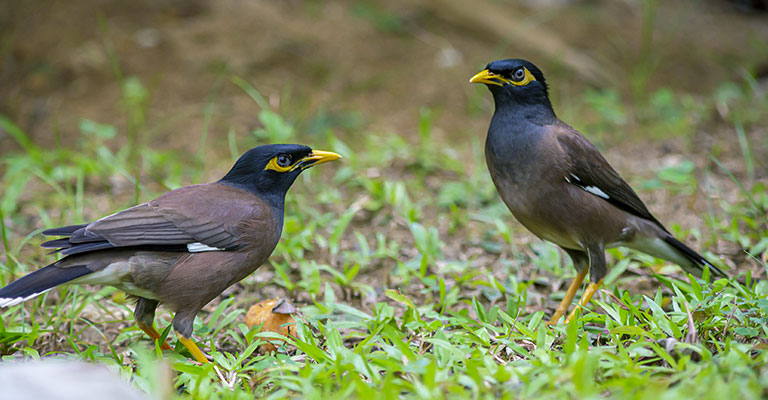
The Common Myna (Acridotheres tristis) is a captivating bird known for its adaptability, distinctive appearance, and resourceful nature.
Here’s an overview of its essential characteristics:
Native Range and Global Spread
Originating from Asia, the Common Myna has successfully established populations across various continents, including Australia, New Zealand, South Africa, and North America. Its ability to thrive in urban environments has contributed to its widespread distribution.
Distinctive Appearance
Easily recognizable by its brown body, black hooded head, and striking yellow eye patches, the Common Myna stands out among other avian species.
Vocalizations
The Common Myna is known for its diverse range of calls, which include whistles, squawks, and ‘clucks,’ adding character to its surroundings.
Dietary Habits
As omnivorous creatures, Common Mynas feed on various food sources, including insects, fruits, and human-generated waste. Their scavenging behavior often leads them to rummage through city trash cans.
Nesting Behavior
Common Mynas are resourceful nest builders, utilizing various locations such as tree cavities and wall crevices. However, their aggressive nesting habits can displace local bird species, leading to conflicts in some ecosystems.
Social Behavior
While exhibiting territorial behavior individually, Common Mynas also display communal tendencies, often flocking together. They fiercely defend their territories from intruders, showcasing a fascinating paradox in their social dynamics.
Conservation Concerns
Despite their adaptability and resilience, Common Mynas are sometimes perceived as invasive due to their impact on native bird species and ecosystems. Efforts to manage their populations and mitigate their effects on local biodiversity are ongoing.
Physical Characteristics of the Common Myna
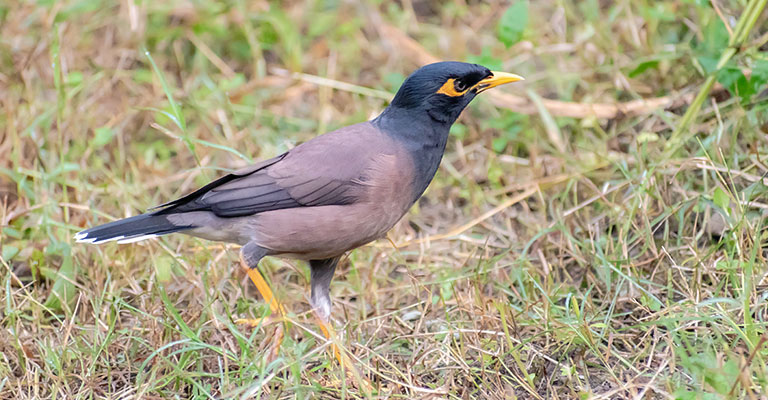
The Common Myna, scientifically known as Acridotheres tristis, is indeed a remarkable bird, notable for its distinct physical characteristics. Each aspect contributes to its striking appearance and adaptability, from its medium-sized stature to its vibrant coloration.
Size
The Common Myna typically measures 9 to 10 inches, placing it squarely within the medium-sized category among avian species. This size provides it with a balance between agility and resilience in various habitats.
Body Color
The body of the Common Myna is predominantly cloaked in shades of brown, offering camouflage amidst natural surroundings while providing a neutral base for its other colorful features to stand out against.
Head/Neck/Chest Color
Glossy black hues adorn the head, neck, and chest of the Common Myna, lending it an air of sophistication and contrast against its brown body. This glossy plumage adds a touch of elegance to its appearance, enhancing its overall allure.
Beak & Leg Color
One of its most distinctive features is the bright yellow coloration of its beak and legs. The vibrant hue serves functional and aesthetic purposes, aiding in foraging and communication while adding a bold splash of color to its ensemble.
Wing Patch Color
The Common Myna reveals striking white patches on its wings during flight or certain displays. These patches contrast stunningly against its brown plumage, catching the eye and adding visual interest to its aerial maneuvers.
Eye Color
With light brown eyes, the Common Myna possesses keen vision, allowing it to spot food sources and potential threats from a distance. This acute eyesight is essential for survival in its natural environment, aiding navigation and hunting.
Habitat and Distribution of the Common Myna
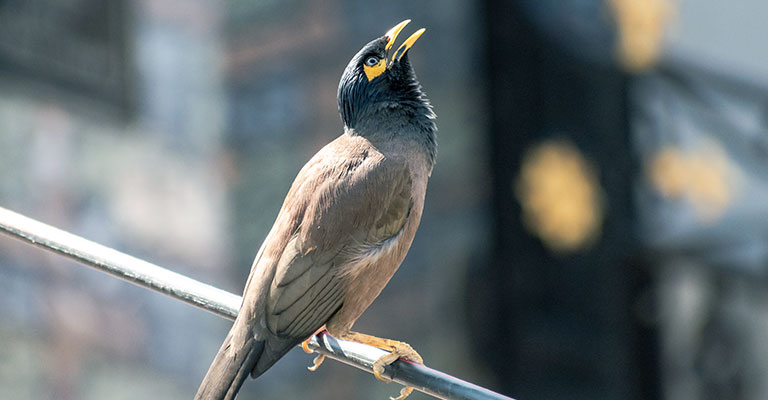
The Common Myna (Acridotheres tristis) is a highly adaptable species with a remarkable ability to establish populations in diverse environments across the globe. Here’s a summary of their habitat and distribution:
Origin
Native to Asia, particularly in the Indian subcontinent and Southeast Asia.
Global Spread
Introduced to various continents and countries for pest control and other purposes. The timeline of their introduction to different regions includes:
- Australia: Introduced in 1862.
- New Zealand: Introduced in 1874.
- South Africa: Introduced in 1902.
Habitat Preference
Common Mynas prefer urban areas where human settlements provide abundant food resources. However, they also adapt to various natural habitats such as forests, grasslands, and rural landscapes.
Expansion and Success
Common Mynas have shown remarkable success in rapidly expanding their territories post-introduction. They have become one of the most widespread bird species in regions where they have been introduced, demonstrating their adaptability and resilience.
Ecological Impact
While their success as an invasive species is noteworthy, it has consequences for local biodiversity. Their aggressive nature can lead to the displacement of native bird species and disruption of ecosystems, posing challenges for conservation efforts.
Behavior and Vocalizations of the Common Myna
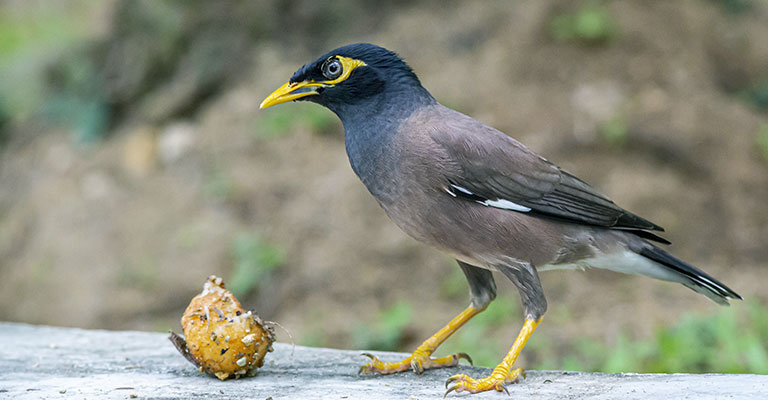
The behavior and vocalizations of the Common Myna (Acridotheres tristis) indeed offer a fascinating glimpse into the complexity of this species:
Social Behavior
Common Mynas exhibit complex social behaviors similar to other members of the Starling family. They are territorial during the breeding season but form communal roosts outside this period.
Aggressive displays and confrontations determine a social hierarchy within their groups.
Vocal Abilities
Common Mynas are known for their impressive vocal abilities, showcasing various calls and songs. These include soft warbles, harsh squawks, and various other sounds.
Notably, they are adept mimics capable of imitating human speech and replicating man-made sounds such as car alarms.
Repertoire
Anecdotal evidence suggests that a single Common Myna can produce up to 18 distinct calls, including:
- Alarm call: A harsh ‘kruk-kruk’
- Contact call: Soft ‘pree-pree’ or ‘preer-preer’
- Distress signal: Loud screeching
- Song: Varied and often intricate
Regional Variations
There are regional variations in the calls and vocalizations of Common Mynas, indicating their adaptability and ability to adjust to different environments and social contexts.
Relationship with Humans
Despite being considered pests in some areas due to their invasive nature and potential impact on native species and agriculture, Common Mynas have successfully integrated into urban landscapes.
Their adaptability and resilience have allowed them to thrive alongside humans, even if their presence sometimes presents challenges.
Threats and Conservation Efforts for the Common Myna
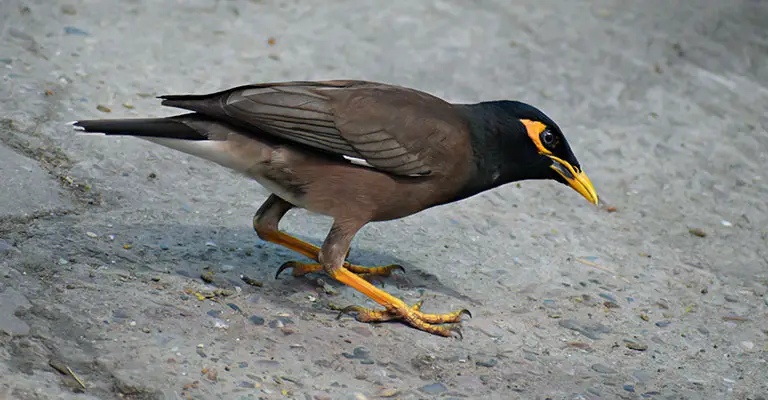
The Common Myna (Acridotheres tristis) faces several threats to its survival, primarily from human activities and environmental changes.
Here’s an overview of these threats and conservation efforts:
Habitat Loss
Rapid urbanization and habitat destruction have led to a decline in the natural habitats of Common Mynas. Loss of suitable nesting sites and food sources in their native environments poses a significant threat to their populations.
Competition with Invasive Species
Common Mynas often compete with other invasive species, such as the European Starling in North America, for food and nesting sites. This competition can further exacerbate their challenges in finding resources.
Perceived Nuisance and Control Measures
Due to their aggressive behavior and potential damage to crops, humans often perceive Common Mynas as nuisances.
As a result, they may be subjected to control measures such as trapping and poisoning, which can harm their populations.
To address these threats and work towards the conservation of Common Mynas, several strategies are being employed:
Development of Humane Control Methods
Efforts are being made to develop and implement control methods that minimize harm to Common Mynas and other non-target species. This includes using deterrents or traps designed to capture birds without causing injury.
Public Education
Educating the public about the ecological role of Common Mynas and the importance of coexisting with wildlife is crucial.
By raising awareness about the challenges faced by these birds and promoting responsible behavior, communities can contribute to their conservation.
Protecting Natural Habitats
Preserving and restoring natural habitats, such as forests and grasslands, provides essential refuge for Common Mynas and other wildlife. Conservation efforts to safeguard these habitats help ensure the species’ long-term survival.
Conclusion
The Common Myna is a captivating example of adaptability in the avian world, spanning 27 countries globally.
However, its remarkable success as an invasive species ranked third on the World’s Worst Invasive Alien Species list brings significant ecological concerns.
While their dominance over native birds poses challenges, proactive management strategies offer hope for mitigating their impacts.
Habitat restoration, targeted pest control, and public awareness initiatives are crucial to fostering a balanced coexistence with these birds.
Understanding the Common Myna’s role in our ecosystems, both its benefits and drawbacks, is essential for fostering healthier and more diverse habitats for all wildlife.